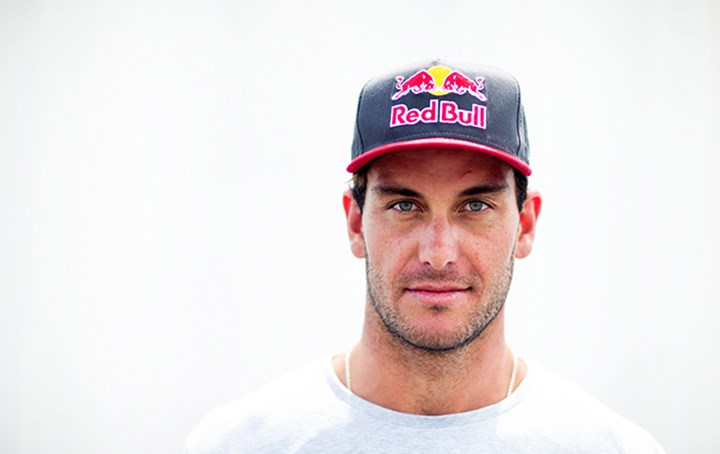
If you thought paddleboarding was a celebrity fad where the Kardashian’s take odd-looking canoes to popular beach destinations, or something explicitly for the Bondi hipsters – you’re wrong. Wallowing around at a monotonous pace while trying to look glamorous is not how Red Bull athlete Matt Poole goes about his business.
The 28-year-old Queenslander takes on The Molokai 2 Oahu Paddleboard World Championship on July 31. Stretching 55 kilometres between Hawaiian Islands Molokai and Oahu and navigating across the 700-metre deep Ka’iwi Channel, the race is one of the toughest obstacle courses Mother Nature has to offer.
Poole and several other Aussies will take the water in the Men’s Solo Unlimited Division and face up to six hours of gruelling cardio. Balancing with their bodies pressed against the board there is nothing but a few inches of carbon fibre separating them from the unforgiving ocean.
“It’s a long time to be on your hands knees,” Poole explains. “It’s a painful, uncomfortable and unnatural position.”
Unlike the stand-up paddleboarder guys (SUPs), Poole can’t hop to his feet for a breather. There are no paddles, oars or webbed gloves – and definitely no stopping for selfies.
“With my paddleboard you use a rudder to steer and your feet are the steering wheel, then your arms are the engine,” says Poole. “It’s a full body workout.”
After years locked in the unorthodox huddle, the ligaments around his kneecaps have been worn to a pulp. The anterior cruciate, prosterior cruciate, medial collateral and lateral collateral – he’s lucky to have one left, let alone all four.
“I usually get swelling, inflammation and even bursting around the kneecap after every race,” says Poole. “It’s a fight just to make sure your joints don’t lock-up.”
The race is paddleboarding’s premier event, with the competitors facing blistering heat and life-threatening obstacles from the moment they bid goodbye to the shore.
“When you first step back on to land and put your feet down; it’s the best feeling ever,” says Poole.
But not all who slip into the Ka’iwi Channel are fortunate enough see land again. In 1978, Hawaiian big-wave legend Eddie Aikau and his shipmates had their Hokule’a (a double-hulled voyaging canoe) blown to pieces by gale force winds. He set off on a paddleboard to seek refuge. His body and board were never found.
Poole is aware of the frightening dangers and risks, and that’s why he leaves nothing to chance when it comes to preparation.
“Before the race it’s all about making sure you are 100 per cent fit and committed, there’s no going back . . . simply put, you need to make it,” says Poole.
Poole pushes his body to the limits, putting in long hours of cardio to ensure his endurance is at its peak. He racks-up at least 16 kilometres of running and cycling each day, adding 160 lengths of an Olympic size pool four days a week and two hours of paddling to match. Weekend rest day? No chance, grins Poole.
“Most of the training I do is to build volume,” he explains.
“I also use the gym, but it’s not to build size or anything, it’s to get my muscles working in a different way.”
Only the brave, the crazy and perhaps those high enough on caffeine-brimmed energy drinks attempt the Molokai 2. Strength and stamina can be trained but nothing can prepare you for the intense mental battle against dehydration caused by nature’s most lethal weapon; the sun. Oh, and there are also sharks. Lots and lots of sharks.
“The conditions are super-hot,” says Poole. “It’s almost 40 degrees and you feel it from the very first minute.
“You have to stay hydrated and keep drinking tons of water. With food you have to keep it simple, there’s nothing worse than having an upset stomach. I stick to white bread with honey and bananas.”
“There has been plenty of encounters with sharks too, but fortunately I haven’t bumped into any myself . . . touch wood.”
Despite winning the event in 2014 it hasn’t always gone swimmingly for the 192-centimetre athlete. In 2012, during his first attempt of the race, the sun almost got the better of him.
“I didn’t put enough sunscreen on and my legs and knees were so badly burnt,” says Poole.
“Blood was washing-up on my board from my legs, they were nearly ripped off. My mind went completely blank and for the last two hours I thought I was going pass out”
Poole is out for revenge and to reclaim his place at the top. But in a sun-scorched ocean teeming with sharks, we just hope he makes it to the other side. To all the paddleboarders – good luck. God knows they’ll need it.















